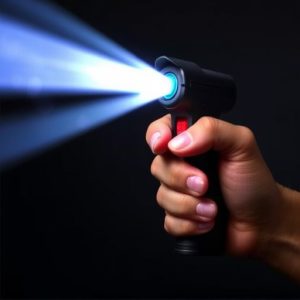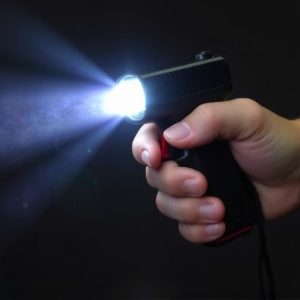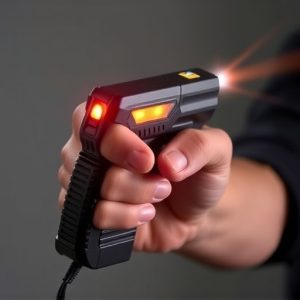Unveiling Stun Guns: Understanding Electrical Discharge for Personal Safety
Stun guns, or electroshock weapons, disable attackers through high-voltage, low-current electrical i…….
Stun guns, or electroshock weapons, disable attackers through high-voltage, low-current electrical impulses that disrupt their neuromuscular system, causing temporary paralysis and disorientation. These non-lethal tools offer users critical time to escape or subdue an assailant. Understanding their inner workings, including battery power, circuit boards, and safety mechanisms, is essential for responsible use. State and local laws govern stun gun legality, with guidelines dictating their last-resort use against imminent harm.
“Personal defense is a serious matter, and understanding effective tools like electrical discharge devices can be life-saving. This article explores the world of stun guns—a popular personal defense weapon. We’ll delve into the science behind their operation, from the electrical discharge process to the physiological effects that render them ineffective against determined attackers. By understanding how stun guns work, you’ll gain insights into responsible ownership, safety training, and legal considerations.”
- Understanding Electrical Discharge for Personal Defense
- The Science Behind Stun Guns: How They Disorient
- Components of a Stun Gun: Essential Elements
- Safety and Training: Responsible Use of Stun Guns
- Legal Considerations: When and Where Can You Use a Stun Gun?
Understanding Electrical Discharge for Personal Defense
Electrical discharge weapons, commonly known as stun guns, offer an innovative approach to personal defense by utilizing electric current to temporarily incapacitate an attacker. Unlike traditional firearms, these devices don’t use projectiles but instead rely on high-voltage, low-amperage electrical impulses to disrupt muscle control in the target’s body.
A stun gun works by delivering a strong electric shock through two electrodes that make contact with the assailant’s body. This sudden jolt of electricity can cause muscles to contract involuntarily, leading to loss of balance, coordination, and strength. The effect is designed to be temporary, usually lasting for a few seconds, allowing the user time to escape or subdue the attacker. How does a stun gun work? Essentially by disrupting the nervous system’s electrical signaling, creating a powerful disorienting force in a non-lethal manner.
The Science Behind Stun Guns: How They Disorient
Stun guns, also known as electroshock weapons, operate on the principle of delivering an electric current to temporarily incapacitate a target. Unlike traditional firearms that use gunpowder and bullets, stun guns generate a powerful electrical discharge, typically in the form of a high-voltage, low-current pulse. This pulse disrupts the normal functioning of the body’s neuromuscular system, causing muscle contractions and disorientation.
The process begins when the user activates the stun gun, which triggers an electronic circuit that generates the electric current. This current is then channeled through two metal probes or electrodes, which are in direct contact with the target’s body. The intense electrical field disrupts the nerve signals responsible for controlling muscle movement, leading to a temporary paralysis and loss of balance. The effect typically lasts for several seconds, providing enough time for the user to escape or subdue their attacker.
Components of a Stun Gun: Essential Elements
A stun gun, also known as an electronic control device (ECD), is a powerful personal defense tool that utilizes electrical energy to temporarily incapacitate an assailant. Understanding its inner workings and components is key to appreciating its effectiveness. At its core, a stun gun consists of several essential elements. Firstly, the power source—typically one or more high-capacity batteries—supplies the necessary voltage for delivering the electric shock. These batteries are connected to a circuit board that regulates the current flow, ensuring precise and controlled discharge.
The heart of the stun gun is the electrochemical cell or capacitor that stores and releases electrical energy. When activated, this component generates a high-voltage, low-current electrical discharge. This powerful pulse disrupts the neuromuscular system, causing muscle spasms, disorientation, and temporary paralysis in the target. Additionally, most stun guns feature protective casing and durable construction to withstand harsh conditions and ensure reliable operation during critical situations. The design also incorporates safety mechanisms, such as triggers or switches, to prevent accidental activation. How a stun gun works lies in its ability to harness this technology, making it an effective personal defense weapon for individuals seeking non-lethal force options.
Safety and Training: Responsible Use of Stun Guns
Stun guns, also known as electroshock weapons, operate by delivering a powerful electrical discharge to disable an attacker temporarily. Unlike firearms, stun guns do not fire projectiles but rather use electrical current to disrupt muscle control in the target’s body, causing them to fall to the ground. This non-lethal force is designed to provide enough time for escape or for other self-defense measures.
Proper safety and training are paramount when considering a stun gun as a personal defense weapon. Users must be educated on how these devices function, including understanding the range of effectiveness, charging instructions, and safe storage practices. Regular practice sessions can help individuals familiarize themselves with the device’s activation mechanism and learn appropriate targeting techniques to ensure accurate and effective use in real-life situations, thereby enhancing their overall safety and confidence.
Legal Considerations: When and Where Can You Use a Stun Gun?
When considering personal defense, understanding the legal framework surrounding stun guns is paramount. The use of electrical discharge weapons like stun guns is regulated by state and local laws, varying widely across different jurisdictions. In general, stun guns are legal in many states if used for self-defense purposes, but there are strict guidelines on when and where they can be deployed.
These regulations often dictate that a stun gun can only be used as a last resort when facing an imminent threat of physical harm. Public spaces like schools, courthouses, and some workplaces typically ban the carry of stun guns to ensure safety and prevent misuse. Additionally, how does a stun gun work? Stun guns operate by delivering a powerful electric current through two metal probes or electrodes, temporarily paralyzing the target’s muscles and causing severe discomfort, pain, and disorientation. This temporary incapacitation allows users to escape potentially dangerous situations.
Understanding the science behind electrical discharge weapons, such as stun guns, is crucial for personal defense. These devices disrupt an attacker’s neuromuscular system through a powerful yet non-lethal electric current, rendering them temporarily incapacitated. By knowing their components and safety protocols, users can ensure responsible deployment. Legal considerations vary geographically, so it’s essential to stay informed about regulations regarding stun gun use. With proper training and awareness, individuals can empower themselves with this innovative personal safety tool, enhancing their ability to protect themselves in various situations.


